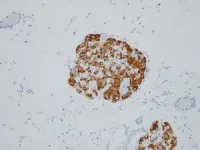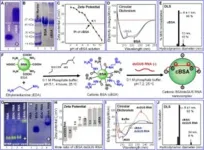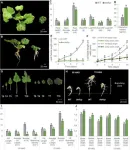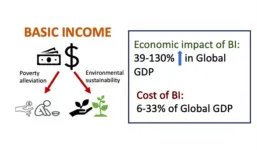(Press-News.org) Online education is effective for teaching complicated topics like quantum information science (QIS) to high school science educators, according to a new paper by University of Texas at Arlington researchers published in The Physics Teacher.
“COVID-19 forced educators to adjust their educational best practices to an unfamiliar virtual classroom, and professional development was no different,” said Karen Jo Matsler, assistant professor in practice for UTeach at UTA and lead author on the study.
Ramon Lopez, professor of physics, was coprincipal investigator on the project. Chandralekha Singh from the University of Pittsburgh was a co-author.
QIS is a new field of science and technology that combines physical science, math, computer science and engineering, and it is key to everyday items like cellphones and solar technology. However, most high schools don’t teach the subject, preventing students from acquiring the skills they need to pursue lucrative jobs.
As part of a $1 million grant from the National Science Foundation in 2021, Matsler and her colleagues aimed to teach QIS to high school science teachers, who could then bring this newly acquired knowledge to their classrooms.
“However, the pandemic made us scrap our original plans for in-person training to an online environment,” Matsler said. “We knew that teaching QIS online would be challenging, but we were pleasantly surprised how well it worked.”
Matsler, Lopez and the team found that what worked best for teaching QIS online was sending participants some of the material in advance to allow them to become familiar with the topics. Then during the sessions, the educators used Zoom—with features such as chat, polling and breakout rooms—to keep the individuals engaged in learning. They also led activities where the learners had a chance to practice teaching the material, another technique that helped individuals stay engaged.
To avoid cognitive overload, the team found main discussions needed to be kept at 15 to 30 minutes, each with breakout sessions lasting five to seven minutes, with a total session time of about 90 to 120 minutes.
“This gave participants ample opportunities to discuss the quantum concepts in small groups varying from two to six participants,” Matsler said. “During these small discussions, leaders rotated in and out of the rooms to check on the participants, clarify instructions and answer questions.”
The instructors also recommend “icebreaker” activities to increase community engagement in virtual learning.
“These icebreaker activities can easily be used to engage students, take attendance and gauge how much the individuals know about the upcoming subject lesson,” Matsler said. “A key element to all of this online learning is making sure the learners feel they are in a safe community to learn and exchange ideas.”
The team also found that short, relevant videos helped teach complicated topics. They recommend keeping the chat function operational during videos to allow participants to ask questions and stay engaged.
“Ideally, QIS is taught in a classroom with hands-on activities to allow learners to see and touch how things like maglev trains and quantum levitation work,” Matsler said. “However, our experiences show that embedding appropriate pedagogy and content with online learning can be effective at teaching these topics. Understanding there is an effective virtual option is important as the country ramps up its efforts to accelerate quantum research and development to stay competitive with other countries in this field.”
END
Online professional education works for complex topics
UTA study shows teachers can learn quantum information science in virtual environment
2024-06-07
ELSE PRESS RELEASES FROM THIS DATE:
Transforming agriculture: engineered nanoparticles for plant gene regulation
2024-06-07
In a major advancement for plant biology and agriculture, researchers have developed a novel method for systemic gene silencing in plants using engineered dsRNA-protein nanoparticles. This technique, which rapidly characterizes gene functions, could revolutionize in planta gene editing. The new approach addresses the longstanding challenge of transporting RNA molecules across plant cell membranes, providing a faster, non-transgenic solution for enhancing crop productivity.
Gene silencing in plants has faced significant challenges, primarily due to the difficulty of transporting RNA molecules across plant cell membranes and achieving systemic effects. Traditional genetic engineering ...
Understanding inequities in nurses’ moral distress during COVID-19
2024-06-07
Research has shown that, when nurses feel they are being prevented from taking a morally justifiable action or achieving an ethical outcome, it contributes to poor mental health, burnout, and intent to leave one’s job. Surveys from the COVID-19 pandemic found that a shortage of personal protective equipment (PPE) and lack of perceived support from hospital administrators were associated with higher levels of this moral distress.
University of Pennsylvania School of Nursing researchers and their collaborators hypothesized that nurses working in hospitals where Black patients predominantly access care—which they call Black-serving hospitals, or ...
Flavor unleashed: a scientific journey into the world of table grapes
2024-06-07
In a recent study, scientists have unlocked the secrets behind the diverse flavors of table grapes. By examining 38 different cultivars, the research offers unprecedented insights into the volatile compounds that shape our taste experiences, paving the way for enhanced grape quality and flavor.
The flavor of table grapes, influenced by various volatile compounds, plays a significant role in consumer preference and marketability. Traditional flavor analysis methods often fail to capture the complexity and diversity of grape flavors, especially in hybrid varieties. Conventional flavor classifications like muscat and foxy are insufficient for describing the wide range of flavors ...
Shrinking statures, growing insights: unraveling the genetic underpinnings of dwarfism in squash
2024-06-07
Unlocking the secrets of nature, a pioneering study has pinpointed a gene mutation with profound implications for plant height and stress tolerance. The discovery lies in the CpDWF5 gene, whose alteration leads to a compact squash plant with a unique resistance to salt stress, marking a leap forward in agricultural science.
In the quest to bolster crop yields and fortify plants against environmental stressors, the delicate interplay of phytohormones stands as a keystone. Yet, our grasp of these genetic levers, particularly those dictating plant stature and resilience to salinity, remains tenuous. Bridging ...
Fat molecule’s inability to bond with shape-shifting protein in cell’s powerhouse linked to an inherited metabolic disease
2024-06-07
FOR IMMEDIATE RELEASE
By studying mutations in yeast and human cells, Johns Hopkins Medicine scientists say they have found that biochemical bonds between fats and proteins in the mitochondrion, the cell’s powerhouse, play a crucial role in how our cells produce energy.
The study results, published June 5 in The EMBO Journal, shed new light, researchers say, on the way the altered mitochondrial membranes found in people with metabolic diseases such as Barth syndrome, a rare genetic disorder that weakens the heart, fail to enable cellular power production.
Metabolism is a set of biochemical reactions central to making energy to fuel life and to getting rid of substances a body no ...
Wildfire smoke reached 99% of U.S. lakes in 2019-2021
2024-06-07
Where there’s smoke, there’s not necessarily fire.
Wildfire smoke, sometimes drifting from hundreds of miles away, touched nearly every lake in North America for at least one day per year from 2019 to 2021, according to a study from the University of California, Davis.
Even more significantly, the study, published in the journal Global Change Biology, found that 89% of the lakes in North America experienced smoke for more than 30 days during each of those three years of intense wildfire activity.
“That was surprising, even ...
Basic income can double global GDP while reducing carbon emissions
2024-06-07
Giving a regular cash payment to the entire world population has the potential to increase global gross domestic product (GDP) by 130%, according to a new analysis published June 7 in the journal Cell Reports Sustainability. Researchers suggest that charging carbon emitters with an emission tax could help fund such basic income program while reducing environmental degradation.
“We are proposing that if we can couple basic income with environmental protection, we can save two birds with one stone,” says first author U. Rashid Sumaila of the University of British Columbia in Vancouver.
Sumaila has been working on ending harmful fishery subsidies worldwide, but many people who rely ...
The rate, nature and transmission of mitochondrial DNA mutations in humans
2024-06-07
A new study from deCODE genetics uses pedigrees and sequence data from 64,806 Icelanders to shed light on the rate and nature of mutations in mitochondrial DNA (mtDNA) and the peculiar dynamics of its maternal transmission.
In a paper published today in Cell, scientists from deCODE genetics, a subsidiary of Amgen, present the largest study to date of germline mtDNA mutations in humans and their transmission across 116,663 mother-child pairs. The study documents the astonishing extent of hypermutability at some positions in mtDNA, including the well-known deleterious A>G mutation at position 3243 which causes the MELAS syndrome. The mutation ...
Prevalence of iron deficiency using 3 definitions among women in the US and Canada
2024-06-07
About The Study: Three definitions of iron deficiency were associated with significantly different prevalence of iron deficiency in women, regardless of self-reported age, pregnancy, or race and ethnicity. Using higher serum ferritin thresholds to define iron deficiency could lead to diagnosis and treatment of more women with iron deficiency and greater reduction of related morbidity.
Corresponding Author: To contact the corresponding author, James C. Barton, M.D., email bartonjames336@gmail.com.
To access the embargoed study: ...
Bariatric metabolic surgery vs glucagon-like peptide-1 receptor agonists and mortality
2024-06-07
About The Study: Bariatric metabolic surgery was associated with greater reduced mortality compared with first-generation glucagon-like peptide-1 receptor agonists (GLP-1RAs) among individuals with a diabetes duration of 10 years or less, mediated via greater weight loss in this cohort study. No differences in the risk for mortality were observed between the treatment modalities among individuals with a longer duration of diabetes, nor in the occurrence of nonfatal major adverse cardiovascular events among all patients.
Corresponding Author: To contact the corresponding author, ...
LAST 30 PRESS RELEASES:
Why nail-biting, procrastination and other self-sabotaging behaviors are rooted in survival instincts
Regional variations in mechanical properties of porcine leptomeninges
Artificial empathy in therapy and healthcare: advancements in interpersonal interaction technologies
Why some brains switch gears more efficiently than others
UVA’s Jundong Li wins ICDM’S 2025 Tao Li Award for data mining, machine learning
UVA’s low-power, high-performance computer power player Mircea Stan earns National Academy of Inventors fellowship
Not playing by the rules: USU researcher explores filamentous algae dynamics in rivers
Do our body clocks influence our risk of dementia?
Anthropologists offer new evidence of bipedalism in long-debated fossil discovery
Safer receipt paper from wood
Dosage-sensitive genes suggest no whole-genome duplications in ancestral angiosperm
First ancient human herpesvirus genomes document their deep history with humans
Why Some Bacteria Survive Antibiotics and How to Stop Them - New study reveals that bacteria can survive antibiotic treatment through two fundamentally different “shutdown modes”
UCLA study links scar healing to dangerous placenta condition
CHANGE-seq-BE finds off-target changes in the genome from base editors
The Journal of Nuclear Medicine Ahead-of-Print Tip Sheet: January 2, 2026
Delayed or absent first dose of measles, mumps, and rubella vaccination
Trends in US preterm birth rates by household income and race and ethnicity
Study identifies potential biomarker linked to progression and brain inflammation in multiple sclerosis
Many mothers in Norway do not show up for postnatal check-ups
Researchers want to find out why quick clay is so unstable
Superradiant spins show teamwork at the quantum scale
Cleveland Clinic Research links tumor bacteria to immunotherapy resistance in head and neck cancer
First Editorial of 2026: Resisting AI slop
Joint ground- and space-based observations reveal Saturn-mass rogue planet
Inheritable genetic variant offers protection against blood cancer risk and progression
Pigs settled Pacific islands alongside early human voyagers
A Coral reef’s daily pulse reshapes microbes in surrounding waters
EAST Tokamak experiments exceed plasma density limit, offering new approach to fusion ignition
Groundbreaking discovery reveals Africa’s oldest cremation pyre and complex ritual practices
[Press-News.org] Online professional education works for complex topicsUTA study shows teachers can learn quantum information science in virtual environment









